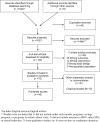Cash transfers for HIV prevention: A systematic review
- PMID: 34843468
- PMCID: PMC8668130
- DOI: 10.1371/journal.pmed.1003866
Cash transfers for HIV prevention: A systematic review
Abstract
Background: Given the success of cash programs in improving health outcomes and addressing upstream drivers of HIV risk such as poverty and education, there has been an increasing interest in their potential to improve HIV prevention and care outcomes. Recent reviews have documented the impacts of structural interventions on HIV prevention, but evidence about the effects of cash transfer programs on HIV prevention has not been systematically reviewed for several years.
Methods and findings: We did a systematic review of published and unpublished literature to update and summarize the evidence around cash programs for HIV prevention from January 2000 to December 17, 2020. We included studies with either a cash transfer intervention, savings program, or program to reduce school costs. Included studies measured the program's impact on HIV infection, other sexually transmitted infections (STIs), or sexual behaviors. We screened 1,565 studies and examined 78 in full-text review to identify a total of 45 peer-reviewed publications and reports from 27 different interventions or populations. We did not do a meta-analysis given the range of outcomes and types of cash transfer interventions assessed. Most studies were conducted in sub-Saharan Africa (N = 23; South Africa, Tanzania, Malawi, Lesotho, Kenya, Uganda, Zimbabwe, Zambia, and eSwatini) followed by Mexico (N = 2), the United States (N = 1), and Mongolia (N = 1)). Of the 27 studies, 20 (72%) were randomized trials, 5 (20%) were observational studies, 1 (4%) was a case-control study, and 1 (4%) was quasi-experimental. Most studies did not identify a strong association between the program and sexual behaviors, except sexual debut (10/18 finding an association; 56%). Eight of the 27 studies included HIV biomarkers, but only 3 found a large reduction in HIV incidence or prevalence, and the rest found no statistically significant association. Of the studies that identified a statistically significant association with other STIs (N = 4/8), 2 involved incentives for staying free of the STI, and the other 2 were cash transfer programs for adolescent girls that had conditionalities related to secondary schooling. Study limitations include the small number of studies in key populations and examining interventions to reduce school costs and matched saving programs.
Conclusions: The evidence base for large-scale impacts of cash transfers reducing HIV risk is limited; however, government social protection cash transfer programs and programs that incentivize school attendance among adolescent girls and young women show the greatest promise for HIV prevention.
Conflict of interest statement
The authors have declared that no competing interests exist.
Figures
References
-
- Bastagli F, Hagen-Zanker J, Harman L, Barca V, Sturge G, Schmidt T, et al.. Cash transfers: what does the evidence say? A rigorous review of programme impact and of the role of design and implementation features. ODI Rep. 2016. doi: 10.13140/RG.2.2.29336.39687 - DOI
-
- Thaler RH, Sunstein CR. Nudge: Improving decisions about health, wealth and happiness. Yale University Press. New Haven, CT; 2008. doi: 10.1080/13571510903227064 - DOI
-
- Baird S, Ahner-McHaffie T, Özler B. Can interventions to increase schooling and incomes reduce HIV incidence among young women in sub-Saharan Africa? Structural Interventions for HIV Prevention. Optimizing Strategies for Reducing New Infections and Improving Care. 2018:31–104. doi: 10.1093/oso/9780190675486.003.0003 - DOI
Publication types
MeSH terms
LinkOut - more resources
Full Text Sources
Medical


